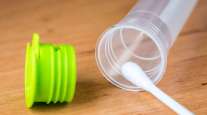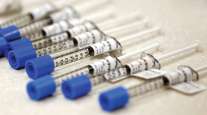Senior Reporter
DOT OKs Drug Testing Drivers Using Oral Fluid Samples

[Stay on top of transportation news: Get TTNews in your inbox.]
The U.S. Department of Transportation on May 1 announced the issuance of a final rule approving use of oral fluid to drug test truck drivers, a move made to deter cheating on urine-based examinations while also addressing privacy concerns of test subjects.
“Adding oral fluid testing as an option is consistent with the careful balancing of an individual’s right to privacy with the department’s strong interest in preserving transportation safety by deterring illicit drug use,” DOT said in a pre-publication Federal Register post. “All oral fluid collections are directly observed because they are always collected in front of the collector. Unlike a directly observed urine collection, an oral fluid collection is much less intrusive on the tested employee’s privacy.”
In addition to the Federal Motor Carrier Safety Administration, the rule also allows use of oral fluid drug testing for safety-sensitive employees in the Federal Aviation Administration, Federal Railroad Administration and Federal Transit Administration. The notice stated that the policy will provide prospective employees with the option of taking a drug test using either the urine or oral fluid method.
The department noted, however, that in order for employers to use the new oral method the U.S. Department of Health and Human Services must first certify at least two laboratories for oral fluid testing. That has not yet been done.
In addition to testing safety-sensitive employees, the oral fluid method allows for testing individuals involved in accidents, for cause and for random testing.

Despite a congressional mandate passed in 2015, HHS has yet to issue a final rule allowing motor carriers to test drivers using hair samples, a method that some carriers say has a longer detection window and can capture lifestyle drug usage. In some cases, carriers maintain that drivers have passed urine tests but failed hair tests.
Although urine testing for many years has been the only official method permitted for drug testing, DOT proposed a plan in February 2022 to adopt oral testing guidelines first approved by HHS in late 2019. “The scientific viability of oral fluid testing has greatly advanced since 2004 to the point where HHS determined that the methodology is accurate and appropriate for federal employee testing,” DOT said.
DOT has said that oral fluid testing is generally less expensive than urine testing, costing $10-$20 less than urine testing, which costs about $35.
But while oral fluid testing may provide a better indicator of an employee’s recent use of the drug and also detects frequent users, DOT noted that there still exists no definitive drug impairment test.
The agency said parties that opposed the earlier oral fluid testing rule generally were concerned that fluid specimens would be used for DNA testing.
The Owner-Operator Independent Drivers Association asked DOT to continue educating industry stakeholders about the scientific and forensic supportability of oral fluid testing, and about how oral fluid testing would be implemented and administered.
Want more news? Listen to today's daily briefing above or go here for more info
“OOIDA reminded us that state and local law enforcement execute roadside testing, and OOIDA wanted us to differentiate and address concerns in the trucking industry about the differences between roadside oral fluid drug tests and DOT’s regulated laboratory tests,” DOT said.
“Traditionally, state and local law enforcement have implemented their own testing entirely outside DOT-regulated drug testing and will continue to do so,” the group said. “Often, law enforcement entities have chosen point-of-collection testing devices that provide initial screening test results, instead of laboratory-based screening testing,”
As for DNA testing, the agency said that federal regulations already prohibit the DNA testing of any specimen collected for a DOT-regulated test.
“As for the commenters who generally opposed drug testing, they offered no data to support why eliminating drug testing would be in the best interest of transportation safety,” the announcement said. “Instead, they merely said that transportation safety-sensitive employees should be permitted to use marijuana."
“However, it is important to remember that the beginning of DOT-regulated testing in 1988 was prompted by marijuana-related accidents that occurred in 1985 (two New York City subway accidents) and 1987 (one railroad accident in Chase, Md.).”




